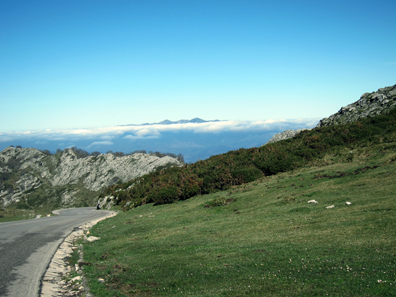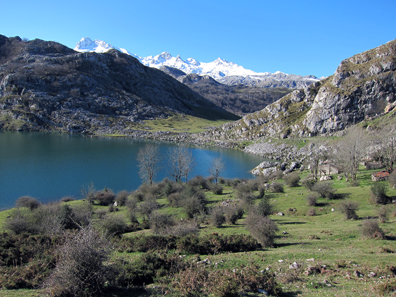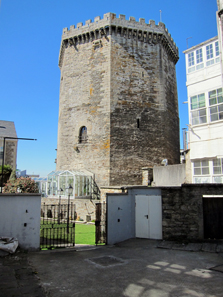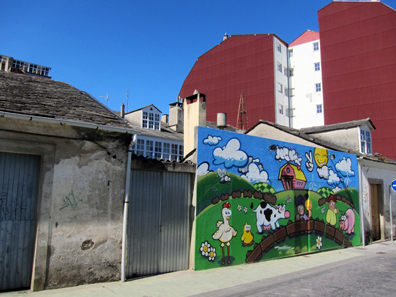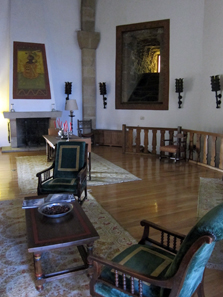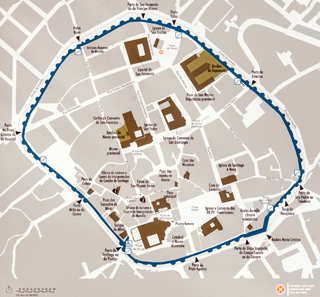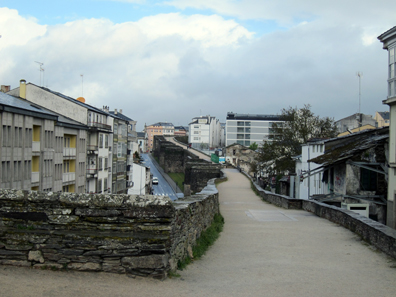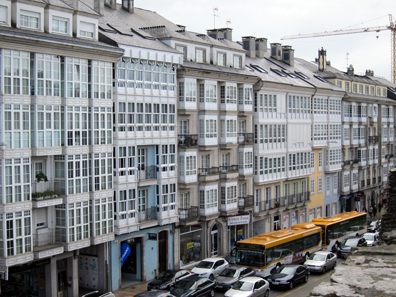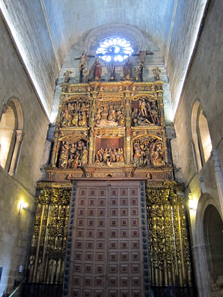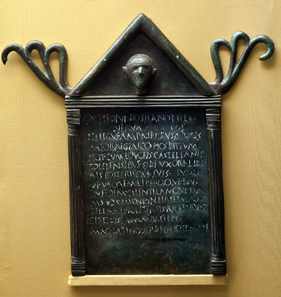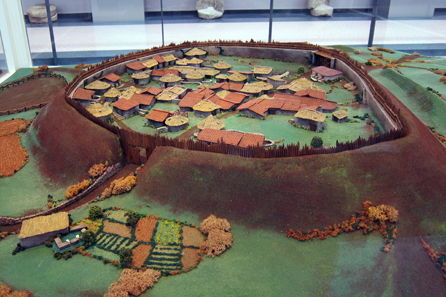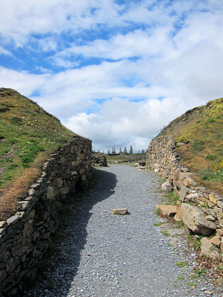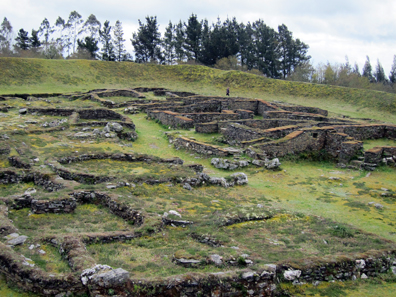by Ursula Kampmann
August 9, 2012 – Can you hazard a guess as to which European country is the most mountainous after Switzerland? Austria? Not a chance! It’s Spain. And besides being incredibly mountainous, Spain can also boast the best-preserved Roman city wall anywhere in the world. Join us on the third leg of our incredible trip as we make our way to the Picos de Europa and then to Lugo.
Easter Monday, April 9, 2012
The alarm rang loudly and incessantly at 7:00 am, and we reluctantly got up, briefly regretting that we had actually decided to get going earlier that day so as to see the Picos de Europa while we had such lovely weather. There’s a small mountain pass at about 1,100 meters directly behind Covadonga, from which you can admire the magnificent, snow-covered peaks that soar approximately 2,500 meters in height.
Above the Clouds: The Mountain Pass to the Picos de Europa. Photo: KW.
The mountain pass is, in theory, closed to private transport from 10:00 am, which is a downright sensible idea. Even with Spain’s status as the most mountainous European country after Switzerland, it still feels like most Spaniards are only familiar with mountains from seeing them on TV – when it comes to driving on the narrow roads, they seem to prefer staying in the middle of them, and passing becomes rather tricky.
A Spanish Mountain Lake. Photo: KW.
We were in luck: at half past nine there was still practically no one on the roads, so we made it to the lower parts of both mountain lakes practically by ourselves. The panorama was stunning, and really underscored why the Muslims left the insurgent Asturians alone. How much damage could a few cattlemen really do in a barren region like this?
We walked around the lake for about an hour, during which time the parking lot completely filled up. Mass migrations of people moved about one lake and then the other. A continuous stream of cars and motorhomes crept uphill and were none too pleased as our car headed back down in the opposite direction at the end of our visit.
A View out onto the Atlantic. Photo: KW.
We no longer regretted our early-morning wake up call. The little excursion had been, as always, well worth our while. Now it was time to continue heading west along the coastal road. As we drove, we quite happily agreed that our guidebook had been completely accurate in its description of the region: the scenery and landscape were striking, the mountains stretching almost all the way to the coast.
At around the halfway mark we stopped for a rest on a headland where we had tea on a steep cliff crowned by a lighthouse and sat and marveled at what Spanish tourism entails. You get there, you get out of the car without even turning off the engine or radio, take a quick picture, take another quick look at the scenery (without really troubling yourself to move to try to get a better view), then get back into the car and keep driving.
The Parador of Vilalba. Photo: KW.
Today’s destination was the parador in Vilalba, where the main focal point is its medieval tower, which dates back to the 15th century. This also used to be a stop on the Camino de Santiago (Way of St. James), which made the city even more popular, since you could take a shortcut here without having to go through Lugo.
In the Streets of Vilalba. Photo: KW.
So much for history. The reality of the place is a completely different story, and it was actually a somewhat useful, if difficult wake-up call to finally see a place that really reflects the harsh truth of Spain’s current economic hardships. There’s no contrived tourist environment here. A forlorn-looking main street leads past cheap shops. Everywhere you look, there are derelict houses and vacant spaces in the development. Every third or fourth house has a ‘For Sale’ sign. It’s not exactly what you’d call ‘romantic.’
Just a few hundred meters along there’s a huge new ultra-modern construction complex. And somewhere between it all, the city residents seem to fall by the wayside, many of them elderly, some clearly disabled, here and there a few boys with a soccer ball. Try as we might, we weren’t able to find anything remotely resembling daily life, or so much as a simple, lively street cafe. The city left us feeling a bit depressed. The mayor must really have his work cut out for him.
Inside the Parador Tower. Photo: KW.
We ate at the parador that night, but not till 8:30 pm of course, as is customary in Spain. Meal times here are considerably different from what we’re used to in Germany – lunch goes from 1:00 to 4:00 pm and no one has dinner until 8:30 pm, at earliest. Since most Spaniards still wouldn’t be caught dead eating at such an ungodly early hour, it was just us tourists sitting and eating till around 10:00 pm.
Northern Spanish cuisine is like a dream: many sausage and meat products as appetizers, a wide array of seafood as the main course. Vilalba’s head chef is known for his subtle combinations, and I have to admit, the papaya on codfish was truly amazing. As was the parfait made from regional St. Simon cheese, a conical cheese that comes in both buttery and smoked varieties. With it, a crisp white wine from the region. We were more than sated (and a little less sober) when we finally got up from our gourmet feast.
The paradors are clearly proud of using local products, and dishes typical of the region are specially marked on the menus. It makes for a wonderful and easy way to embark on your very own culinary discovery tour.
Tuesday April 10, 2012
We had been completely convinced that the beautiful weather would last, but things never turn out the way you expect. It was raining when we woke up. People were walking around with huge umbrellas and it finally dawned on me why a good third of the products for sale in the parador boutiques are rain-themed: raincoats, rain hats, umbrellas, etc. Could it be that Galicia owes its astounding greenness to the abundant and incessant rain?
Lugo’s Roman City Wall. Photo: KW.
Anyway … our route took us to Lugo, the ancient ‘Lucus Augusti.’ Originally, Paulus Fabius Maximus positioned a military camp here in 13 BC in order to secure the North of Spain during the Roman conquest. People had lived here before this, of course, Celtic inhabitants from the Capori tribe. In subsequent decades, it became the seat of a conventus (judicial centre), one of three in Galicia.
Layout of Lugo. Photo: Luis Miguel Bugallo Sánchez (Lmbuga) / Wikipedia.
The rich deposits of gold mined here meant that Lugo and its surrounding area were very valuable to the Romans, and possibly also the reason that the city remained significant to the Suebi and Visigoths. The city’s decline only began with the Arabic conquest between 713 and 740. Along the way, the Roman city walls from the 3rd century AD weren’t used as a quarry, but rather for fortification during the rebuilding of the medieval city in the 10th century. For centuries, the massive city walls greeted Jacobean Pilgrims coming here to worship the relics of St. Froilán. Today, you have to first struggle through endless suburbs in order to get to the most completely preserved Roman Empire city wall, which has been a UNESCO World Heritage Site since 2000.
Along the City Wall. Photo: KW.
We saw the wall immediately, but what eluded us was a place to park. Lugo is exceedingly good at concealing their parking garages and the elaborate parking directional system only makes matters worse, somehow always managing to lead you in the completely wrong direction. Either way, we finally found parking, unpacked the umbrella and were soon on the city wall.
A View of the Glassed-In Balconies From the City Wall. Photo: KW.
The circuit along the wall is 2,117 meters long and features 71 towers. We might have been the only tourists there, but we were far from alone, since the citizens of Lugo use this traffic-free trail as a promenade, dog toilet and workout trail. As the rain trickled peacefully down upon us, I started thinking to myself (as I am wont to do …): Why, for instance, are there hardly any balconies in this country, just tons of glassed-in winter gardens? A quick look later at the climate data for the region quickly cleared up this conundrum by informing me that Galicia has an average of 13 days of rain in April. I think we’d pretty much worked our way through all of them by that point!
The Cathedral’s Former High Altar, Now in Transept. Photo: KW.
The cathedral in Lugo is also well worth seeing, with its old high altar from the 16th century in the side chapels. You really have to look carefully to recognize that you’re standing in what was originally a Romanesque church that was subsequently modernized with Baroque elements.
A Permit for a Celt to Construct an Inn – Provided I’ve Correctly Understood the Spanish Text. Photo: Luis Miguel Bugallo Sánchez (Lmbuga) / Wikipedia.
Although I’d originally expected it to be rather dull, the provincial museum was absolutely spectacular (although photography is strictly forbidden there, so we have to rely on Wikipedia to fill in the gaps). We worked our way through Galician art from the 19th and 20th centuries, local jewellery, some more or less spectacular archaeological finds and at least five display cases filled with coins.
It was only at the end that we discovered the stunning private collection of Alvaro Gil, which is on permanent loan to the museum. It’s like a treasure-filled room, full of golden torques, some of immense size. There were also bullions from the region and other gold jewellery. We just stood there, agape. There are no pictures, sadly (see above), but I would strongly advise everyone to take in this splendour for themselves. These pictures from the Internet, here and here, are just a small sampling of what’s in store.
A model of the Celtic Settlement of Viladonga. Photo: KW.
From Lugo we drove north to pay a visit to a place mentioned in a footnote in my guidebook, the Celtic Castro de Viladonga. We went with no expectations whatsoever, and it was almost 2:00 pm anyway, the time when all museums in Spain close for siesta). But much to our surprise, not only was the excavation site open and accessible, but the associated museum was as well. The museum itself was a gem and was equipped according to all the latest insights into museum education, with a host of impressive models, animations and reconstructive drawings.
Small Coin Hoard of Bronzes from the 4th and 5th Centuries AD. Photo: KW.
According to the available data, some 300 to 500 people are said to have lived in the small fort during its heyday. The site was steadily populated from around 50 BC to 450 AD. How do we know this? Because a whole host of Roman coins were discovered in Viladonga that were then featured in a lavish publication which was even available for purchase at the museum (we obviously couldn’t resist!).
Entrance to the Small, Rampart-Protected Village. Photo: KW.
Afterwards we went to the wonderfully restored excavation site. It had stopped raining by this point, so we were able to fully enjoy the superb foundations. The small village was fortified with a perhaps 7-8 m high rampart, in front of which there were trenches and barbicans that made it exceedingly difficult for any enemy – man or beast– to attack the residents.
A View of the Excavation Site. Photo: KW.
The settlement is divided into several insulae, with a sort of road snaking between them, and parallel to the wall is an untilled area, which likely also served as a means of getting from one building to another. The building layouts are primarily round or oval, and some are square shaped. Thanks to the many quality animated films we enjoyed at the museum, it was very easy to imagine what life in this Celtic village must have been like.
Moss-Covered Trees. Photo: KW.
The beautiful flora served as a wonderful additional attraction. The meadows were strewn with small, wild daffodils. All the trees had long mossy beards, which hints at just how clean the air is here and probably also just how much moisture is constantly in that air.
We briefly considered whether we should take advantage of the nice weather to drive to A Coruña. But by that point we were too tired and decided instead to test out our hotel’s legendary cuisine again and relax. Did we make the wrong call? Well, from what we could gather from the weather forecast, a new low-pressure trough was advancing and we could pretty well count on steady rainfall for the next day. At any rate, it can’t possibly be so foggy that we won’t be able to see the famous Roman lighthouse of Corunia!
You can read all other parts of this diary here.




